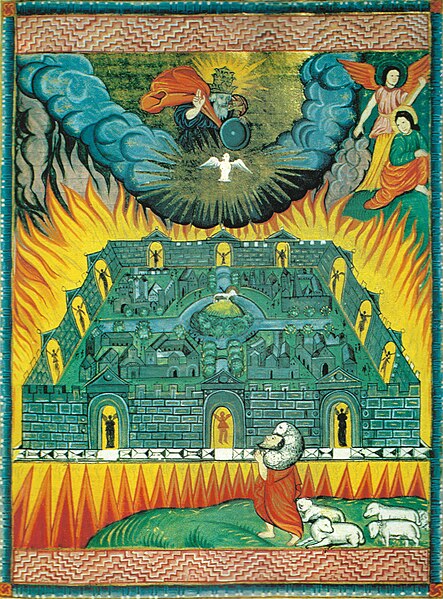In the Book of Ezekiel in the Hebrew Bible, New Jerusalem is Ezekiel's prophetic vision of a city centered on the rebuilt Holy Temple, the Third Temple, to be established in Jerusalem, which would be the capital of the Messianic Kingdom, the meeting place of the twelve tribes of Israel, during the Messianic era. The prophecy is recorded by Ezekiel as having been received on Yom Kippur of the year 3372 of the Hebrew calendar.
John of Patmos watches the descent of New Jerusalem from God in a 14th-century tapestry
The New Jerusalem and the River of Life (Apocalypse XII), Beatus de Facundus, 1047
The New Jerusalem. Armenian manuscript by Malnazar and Aghap'ir in New Julfa bible, 1645.
Folio 55r of the Bamberg Apocalypse depicts the angel showing John the New Jerusalem, with the Lamb of God at its center.
The Book of Ezekiel is the third of the Latter Prophets in the Tanakh and one of the major prophetic books in the Christian Bible, where it follows Isaiah and Jeremiah. According to the book itself, it records six visions of the prophet Ezekiel, exiled in Babylon, during the 22 years from 593 to 571 BC, although it is the product of a long and complex history and does not necessarily preserve the very words of the prophet.
A mid-12th-century Flemish piece of copperwork depicting Ezekiel's Vision of the Sign "Tau" from Ezekiel IX:2–7. The item is held by the Walters Museum.
Manuscript in Hebrew and Latin from England, early 13th century, showing part of Ezekiel 30
Monument to Holocaust survivors at Yad Vashem in Jerusalem; the quote is Ezekiel 37:14.
The Visionary Ezekiel Temple plan drawn by the 19th-century French architect and Bible scholar Charles Chipiez








